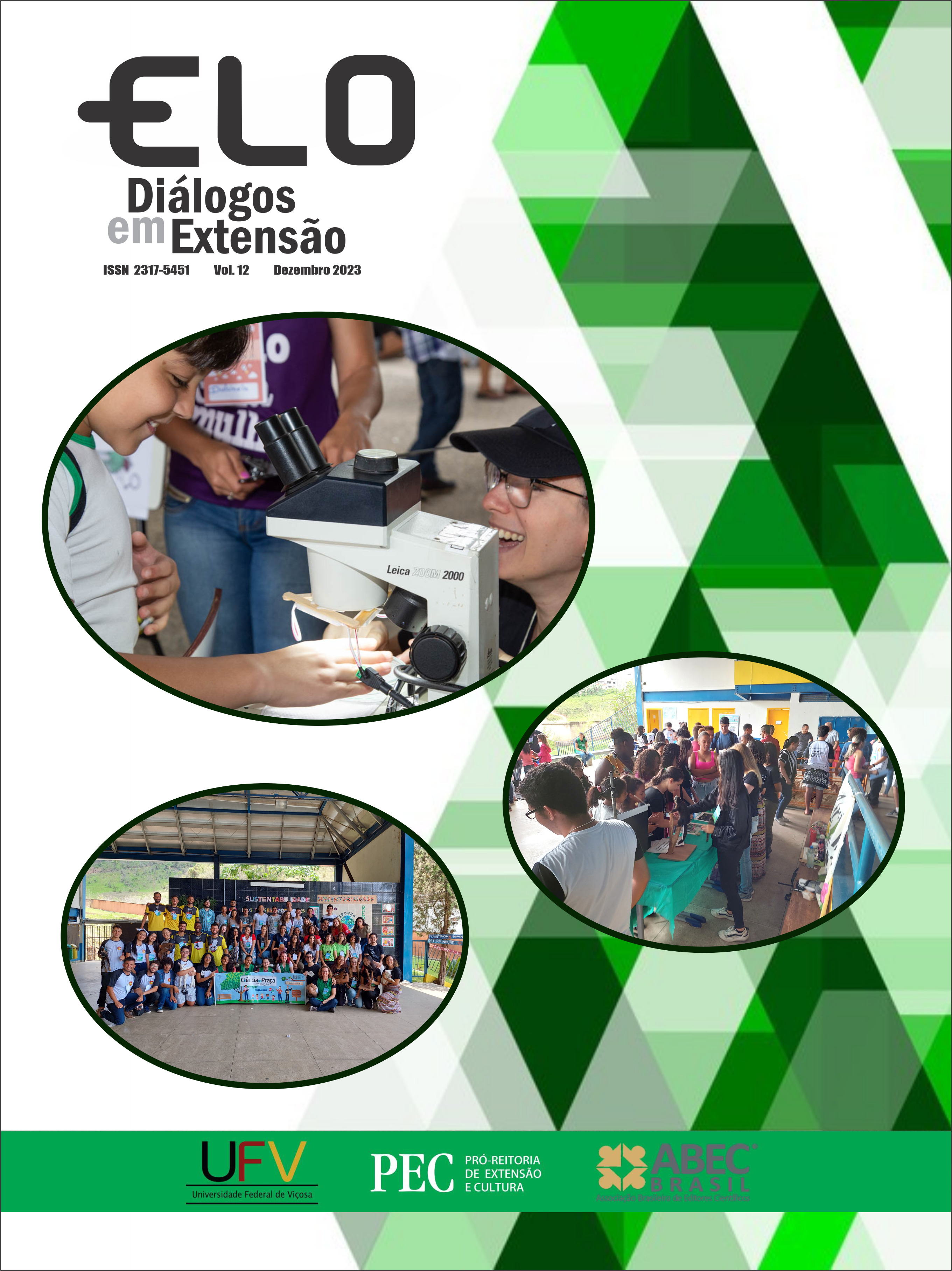WebCiência as an articulation strategy between scientific communication and university extension
DOI:
https://doi.org/10.21284/elo.v12i.15659Keywords:
Science outreach, Social media, YouTube®, ChemistryAbstract
Digital communication platforms have become essential as tools to strengthen communication between the university and the external community. This work reports the use of YouTube® in the extension action “WebCiência IQ-UFG” carried out by the Federal University of Goiás (UFG), analyzing metrics of social reach in the internal and external communities of the UFG. The promoted webinars had a broad profile, with emphasis on those of general nature, associated with Teaching & Society themes, and those on the frontiers of Chemistry, especially in the health area. Views and likes did not show significant differences between the remote and face-to-face teaching modalities, with a tendency to replace UFG internal participants with an external audience in the webinar cycle after the return to face-to-face activities. The action proved its extension nature, as in all webinars there was the participation of the external public, covering all Brazilian states and other countries.
Downloads
References
BAREFOOT, Darren; SZABO, Julie. Manual de Marketing em Mídias Sociais. São Paulo: Novatec, 2016. 310 p.
BASTIAN, Mathieu; HEYMANN, Sebastien; JACOMY, Mathieu. Gephi: An open source software for exploring and manipulating networks. Proceedings of the International AAAI Conference on Web and Social Media, v. 3, n. 1, p. 361-362. 2009.
BRASIL. Painel Coronavírus. 2023. Disponível em: https://covid.saude.gov.br. Acesso em: 14 Mar. 2023.
CARDOSO, Maria Cristina; FERREIRA, Carolina Pacheco; SILVA, Cristina Martins da; MEDEIROS, Gabriela de Melo; PACHECO, Geovana; VARGAS, Rebeca Maldonado. Utilização das redes sociais em projeto de extensão universitária em saúde durante a pandemia de COVID-19. Expressa Extensão, [S. l.], v. 26, n. 1, p. 551–558, 2021.
CORDOVA, Tania. Curtir, comentar e compartilhar: o uso do facebook na educação de jovens e adultos. Revista E-Tech: Tecnologias para Competitividade Industrial, [S.L.], v. 9, n. 1, p. 17-31, 2016.
DAS, Samarjit. Pattern recognition using the Fuzzy C-Means technique. International Journal of Energy, Information and Communications, v. 4, n. 1, p. 1-14, 2013.
DE’ATH, Glenn. Multivariate Regression Trees: A new technique for modeling species-environment relationships. Ecology, v. 83, n. 4, p. 1105-1117, 2002.
Digital 2023: Global Overview Report. Disponível em: https://datareportal.com/reports/digital-2023-global-overview-report. Acesso em: 16 Mar. 2023.
FRANÇA, Tania; RABELLO, Elaine Teixeira; MAGNAGO, Carinne. As mídias e as plataformas digitais no campo da Educação Permanente em Saúde: debates e propostas. Saúde em Debate, v. 43, n. Especial 1, p. 1-10, 2019.
GEPHI. The open graph viz platform, version 0.9.7. 2022.
GROSSI, Marcia Gorett Ribeiro; MURTA, Flávio Cançado; SILVA, Mislene Dalida. A aplicabilidade das ferramentas digitais da Web 2.0 no processo de ensino e aprendizagem. Revista Contexto & Educação, v. 33, n. 104, p. 34-59, 2018.
GUIMARÃES, Ana Lúcia; DIAS, Ana Cecília Machado; ARGENTO, Heloísa. Redes sociais e educação: repensando metodologias e estratégias de ensino-aprendizagem. Associação Brasileira de Educação a Distância - ABED, [S.L.], p. 1-9, 2017.
LEBART, Ludovic; PINCEMIN, Bénédicte; POUDAT, Céline. Analyse des Données Textuelles. Montreal: Presses de l’Université du Québec, 2019.
LEGENDRE, Pierre; GALLAGHER, Eugene D. Ecologically meaningful transformations for ordination of species data. Oecologia, v. 129, p. 271-280, 2001.
LESSA, Bruna; LEITÃO, Débora; SILVA, Tamiris. Tecnologia digital e educação continuada: o projeto de extensão sala aberta em tempos pandêmicos. ETD-Educação Temática Digital, v. 24, n. 1, p. 171-186, 2022.
MANLY, Brian Frederich John; ALBERTO, Jorge Augusto Navarro; DIAS, Carlos Tadeu dos Santos. Métodos Estatísticos Multivariados: Uma Introdução, 4ª edição. Porto Alegre: Bookman, 2019.
MARTINS, Vivian; ALMEIDA, Joelma. Educação em tempos de pandemia no Brasil: saberes fazeres escolares em exposição nas redes e a educação on-line como perspectiva. Revista Docência e Cibercultura, v. 4, n. 2, p. 215-224, 2020.
MELO FILHO, Edilson Targino; SILVA, Maria Luana. Webconferências como estratégias de desenvolvimento de competências. Revista Bibliomar, v. 20, n. 1, p. 217-228, 2021.
ONU. Objetivos de Desenvolvimento Sustentável: Agenda 2030. Nações Unidas Brasil: Brasília, 2018.
R CORE TEAM. R: A language and environment for statistical computing. R Foundation for Statistical Computing: Vienna, version 4.1.3, 2022.
REATEGUI, Eliseo Berni; EPSTEIN, Daniel; LORENZATTI, Alexandre, KLEMANN, Mirian. Sobek: A text mining tool for educational applications. In: International Conference on Data Mining: Las Vegas, p. 59-64, 2011.
SÁ, Ana Cláudia Antonio Maranhão; LOPES, Janice Pereira; SANTOS, Maria Bethânia Sardeiro dos; MORAES, Moema Gomes (Orgs). Diretrizes didático-pedagógicas para a organização do ensino remoto na UFG. Goiânia: Cegraf UFG, 2020.
SILVA JÚNIOR, Edson Prestes. Introdução à Teoria dos Grafos. Instituto de Informática: UFRGS, 2020.
SILVA, Robson Almeida; BRITO, Mariele Moraes; OLIVEIRA, Geisa Sales; SAMPAIO, Neiane Oliveira; SANTOS, Amanda Pereira; GONZAGA, Fabiany Cruz. Ciclo de seminários em química dos diversos saberes – UESB: um relato de experiência durante a pandemia. Revista Extensão & Cidadania, v. 9, n. 16, p. 123-135, 2021.
SPAD. Système portable pour l’analyse des données, version 5.5. Decisia: Paris, 2002.
WARD, Joe H. Jr. Hierarchical grouping to optimize an objective function. Journal of the American Statistical Association, v. 58, n. 301, p. 236-244, 1963.
Downloads
Published
How to Cite
Issue
Section
License
Copyright (c) 2023 Revista ELO – Diálogos em Extensão

This work is licensed under a Creative Commons Attribution 4.0 International License.
Authors who publish in this journal agree to the following terms:
A. Authors grant the journal the right of first publication, with the work simultaneously licensed under the Creative Commons Attribution License which allows the sharing of work with acknowledgment of authorship and initial publication in this journal.
B. Authors are authorized to take additional contracts separately, for non-exclusive distribution of the version of the work published in this journal (e.g. publish in institutional repository or as a book chapter), with acknowledgment of authorship and initial publication in this journal.
C. The journal holds the right to make format, orthographic and grammatical changes in the article to ensure the language standards, respecting the author’s style as well.
D. The opinions expressed by the authors are of their exclusive responsibility.















